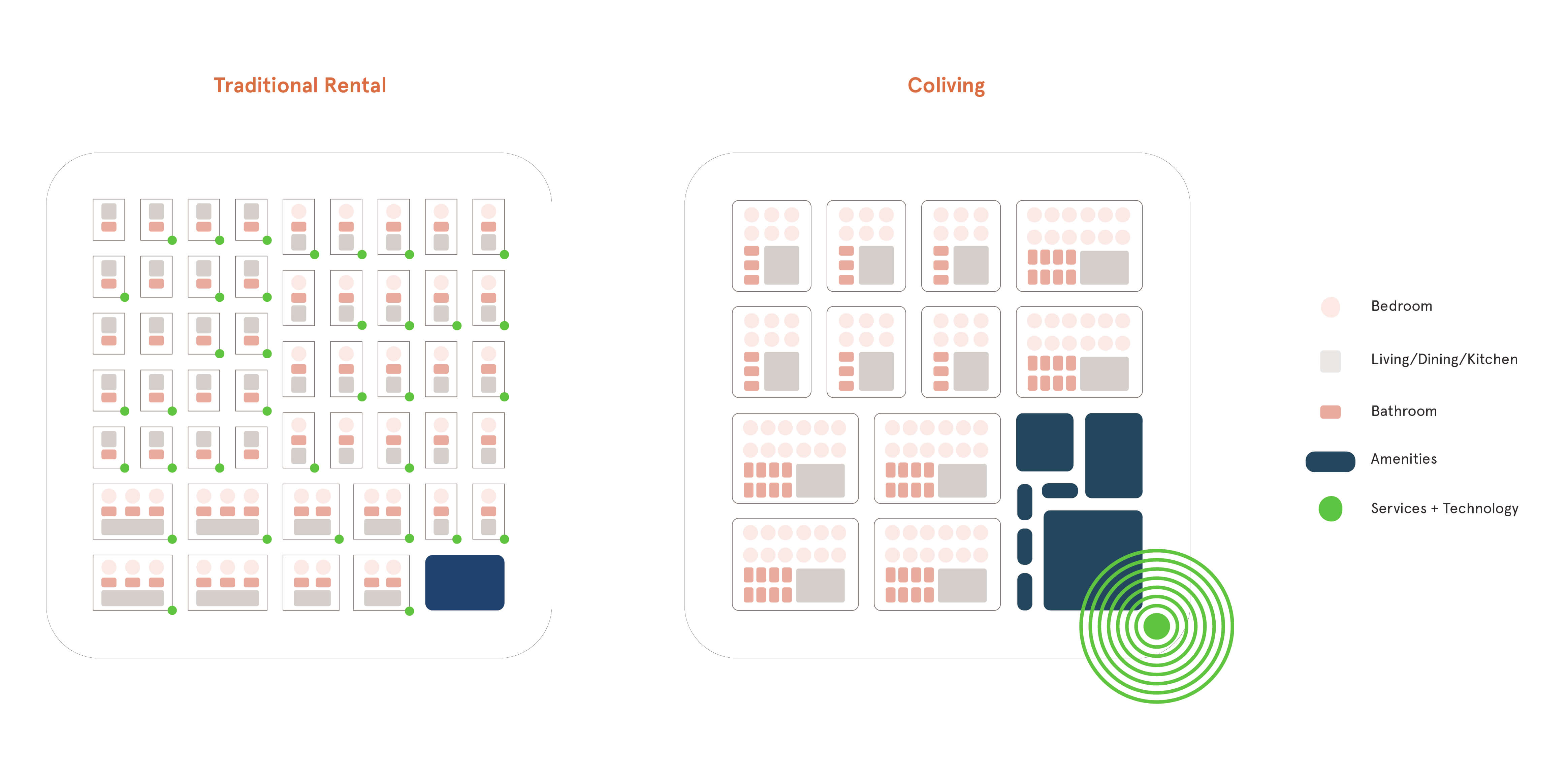Following the rise of coworking spaces, “coliving” is a buzzy concept quickly gaining traction and interest in major cities. If you’re wondering “what is coliving?” the general idea behind it is to get around the high cost of living in dense urban areas such as New York, Los Angeles, San Francisco, Chicago, Washington, DC, and Seattle. At Common, coliving means sharing, spatial protocol, and considerate design.
Behind the buzzy term, coliving is a concept that has been around for a long time. Coliving has taken many forms throughout history, including intergenerational communities in Scandinavia, communes in Arizona, circular cities in China, and SROs in New York. Each iteration is a different way of people coming together and organizing their housing environment in order to facilitate sharing. Today’s urban renters have a strong need for a similar housing model; one that will allow them to live in well-designed homes with an intentional community that supports their fast-paced lifestyles in the city.
By putting value directly into the design, comfort, and convenience of the homes as well as the experiences they facilitate, coliving is solving many of the frustrations of the current urban housing crisis. As the leader in this expanding market, Common believes in the sharing economy and hopes to define coliving as the key solution to make city living accessible and better for modern renters.
Sharing = Affordability
In an urban environment, coliving facilitates the sharing of a very limited resource: space. Space has become unaffordable, and in order for more people to have access, spaces must be shared. Through sharing, coliving is able to increase the amount of available spatial resources accessible to each individual by transforming traditionally disparate apartments into well-planned spaces with valued amenities.
Sharing reduces waste and builds community among people who likely wouldn’t have interacted otherwise. Individuals who participate in sharing give up privacy in some parts in their routine (such as cooking dinner or lounging). But in exchange, they save time and money, and also gain access to a diverse set of activities (i.e. work, exercise, gathering, play, and entertainment) that further enrich their lives.

“Moving into a coliving space, I was worried that I would sacrifice my privacy by sharing a space, but honestly I ended up with even more room to chill. Between community spaces, roof decks, lounges, and a movie room I don’t feel like I’ve given up anything by moving into this home.” – Common Member Justin G.
Bringing spatial protocol to homes
Coliving is not defined by its shape, but rather the life inside the form. Although spaces are designed to carry out life’s needs, coliving is not confined to a specific architectural typology. It is instead a protocol of spatial adjacencies and uses which allows it to be adapted to any environment.
For example, in Brooklyn, it can take the form of a 4-story brownstone, with gathering spaces in the cellar and on the rooftop. It can also be a 30-story apartment, with ample amenities that provide its residents with a private bedroom and an enhanced lifestyle at an affordable rent price.

“I had the choice of living in a cramped efficiency, but Common offered a full-size home, with an outdoor patio, awesome neighborhood, exceptional amenities, great transportation options, security, and it just made good financial sense.” – Common Member John B.
Considerate design for optimal living
The current urgent demand for an affordable, shared living is already manifest in roommate living. Nearly 78 million Americans live with a non-family member roommate. Residents in dense cities who move to dense cities often search for a Craigslist roommate and split an apartment by putting up a temporary wall to create a private bedroom or live in other ad hoc spatial solutions for cheaper rent.
Coliving accounts for the essential elements of a comfortable living experience in a building designed for high density. Considerations such as the right sharing ratio for bathrooms, or the proper amount of storage volume per person in the shared kitchen help remove the pain points when there is reduced space.

“I work from home and was concerned that I wouldn’t have enough space or peace and quiet. The opposite is true – I work in a gorgeous, sunny room and pretty much have the floor to myself during the day.” – Common Member LeeAnn W.
Coliving, in relation to the real estate market
As urban populations balloon and rent rises, denser housing stock is an effective solution to the housing crisis. Despite this need for density, city governments and residential real estate developers have not responded to the evolving market demands. The rental housing stock created over the last decade has been focused on private studios, 1-bedrooms, and 2-bedroom units.
Coliving is one of the best and most direct means to achieve optimal density and affordable housing in the modern urban context. By building 3+ bedroom suites (or even 12, or 20!), coliving allows more people access to the same amount of space. When designing for coliving, the focus is on facilitating the sharing of spatial and program operations of a home while eliminating the redundancies of spaces and the pain points of living with roommates. This intersection of otherwise isolated routines will then help create new, diverse opportunities and strong communities.
Through architectural design, experience design, event planning, technology-enabled communication design, and resident support, Common aims to make sharing desirable and affordable for all types of residents.
View this post on Instagram
More about coliving:
A brief history of coliving
Top 5 things you’ll want to know about coliving
4 things to expect from coliving
Your biggest questions about coliving, answered
Is coliving right for you?
Explaining coliving, from an architectural design perspective
How does coliving differ from traditional rentals?

